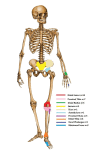Advantages of Pressurized-Spray Cryosurgery in Giant Cell Tumors of the Bone
- PMID: 27761276
- PMCID: PMC5056651
- DOI: 10.5152/balkanmedj.2016.150473
Advantages of Pressurized-Spray Cryosurgery in Giant Cell Tumors of the Bone
Abstract
Background: Giant Cell Tumor is considered a benign, local and aggressive tumor. Although considered a benign bone tumor, it is still the subject of discussion and research because of the associated local bone destruction, as well as high rates of recurrence and distant metastases. Options are being developed for both surgical techniques and adjuvant therapies.
Aims: The present study evaluated the administration of cryotherapy via a pressurized-spray technique in giant cell tumors of the bone.
Study design: Cross-sectional study.
Methods: The study included 40 patients who were treated with extensive curettage and cryotherapy at various locations during the period from February 2006 to December 2013. Informed consent forms were obtained from the participants and ethics committee approval was taken from the local ethics committee of Ondokuz Mayıs University. The pressurized-spray technique was performed using liquid nitrogen. The patients were evaluated with respect to age, gender, radiological appearance, treatment modality, duration of follow-up, skin problems and recurrence.
Results: Twenty-one patients were female; 19 were male. The average age of the patients was 33 years (range: 16-72 years), and the average duration of follow-up was 43 months (range: 12-80 months). The average time from the onset of the complaints to the diagnosis was 6 months (range: 2-12 months). Based on the Campanacci classification: 9 patients were Grade I; 25 patients were Grade II; six patients were Grade III. The lesion was located in the femur in 14 patients, in the tibia in 11 patients, in the radius in 5 patients, in the pelvis in 4 patients, in the fibula in 3 patients, in the metatarsal in 2 patients and in the phalanges of the hand in one patient. One patient had postoperative early fracture. None of the patients had skin problems and infection. Three (7.5%) of the patients had recurrence.
Conclusion: It was found that cryotherapy was highly effective in the lesions, especially those located in the femur and tibia and remained insufficient in the lesions expanded outside the cortex. Wound healing problems, infection and fracture risk are lower with this technique.
Keywords: Giant cell tumor; bone; cryotherapy; pressurized-spray technique; surgical treatment.
Conflict of interest statement
No conflict of interest was declared by the authors.
Figures






Similar articles
-
[Case analysis on treatment and recurrence of giant cell tumor of bone].Zhongguo Xiu Fu Chong Jian Wai Ke Za Zhi. 2006 Oct;20(10):1007-10. Zhongguo Xiu Fu Chong Jian Wai Ke Za Zhi. 2006. PMID: 17140075 Chinese.
-
Risk factors for recurrence of giant cell tumours of bone.J Orthop Surg (Hong Kong). 2014 Apr;22(1):108-10. doi: 10.1177/230949901402200127. J Orthop Surg (Hong Kong). 2014. PMID: 24781627
-
The outcomes of treatment of giant cell tumor of bone around the knee.J Med Assoc Thai. 2012 Sep;95 Suppl 9:S122-8. J Med Assoc Thai. 2012. PMID: 23326994
-
Giant cell tumor of bone.Clin Orthop Relat Res. 1986 Mar;(204):45-58. Clin Orthop Relat Res. 1986. PMID: 3514036 Review.
-
Cryosurgery and acrylic cementation as surgical adjuncts in the treatment of aggressive (benign) bone tumors. Analysis of 25 patients below the age of 21.Clin Orthop Relat Res. 1991 Jan;(262):42-57. Clin Orthop Relat Res. 1991. PMID: 1984931 Review.
Cited by
-
'Triple clear': a systematic and comprehensive surgical process for Campanacci grades II and III giant cell tumors of the bone, with or without pathological fracture and slight joint invasion.World J Surg Oncol. 2023 Mar 29;21(1):114. doi: 10.1186/s12957-023-02982-2. World J Surg Oncol. 2023. PMID: 36978172 Free PMC article.
-
Global Prevalence and Risk of Local Recurrence Following Cryosurgery of Giant Cell Tumour of Bone: A Meta-Analysis.Cancers (Basel). 2022 Jul 8;14(14):3338. doi: 10.3390/cancers14143338. Cancers (Basel). 2022. PMID: 35884399 Free PMC article. Review.
-
Giant Cell Tumor of the Proximal Femur with Pathological Fracture of Femoral neck.J Orthop Case Rep. 2025 Jun;15(6):113-118. doi: 10.13107/jocr.2025.v15.i06.5684. J Orthop Case Rep. 2025. PMID: 40520736 Free PMC article.
-
Effect of Local Adjuvants Following Curettage of Benign and Intermediate Tumours of Bone: A Systematic Review of the Literature.Cancers (Basel). 2023 Aug 25;15(17):4258. doi: 10.3390/cancers15174258. Cancers (Basel). 2023. PMID: 37686534 Free PMC article. Review.
-
The effect of adjuvant cryotherapy added to well-performed high-speed burr curettage on the long-term surgical outcomes of chondroblastoma cases.Jt Dis Relat Surg. 2023 Apr 26;34(2):338-345. doi: 10.52312/jdrs.2023.936. Jt Dis Relat Surg. 2023. PMID: 37462637 Free PMC article.
References
-
- Ghert MA, Rizzo M, Harrelson JM, Scully SP. Giant-cell tumor of the appendicular skeleton. Clin Orthop Relat Res. 2002;400:201–10. http://dx.doi.org/10.1097/00003086-200207000-00025. - DOI - PubMed
-
- Cooper A, Travers B. Surgical Essays. London: Cox&Son; 1818.
-
- Virchow R. Die Krankhaften Geschwulste. Berlin: Hirschwald; 1846.
-
- Campanacci M. Giant cell tumor. In: Gaggi A, editor. Bone and soft-tissue tumors. Bologna: Springer-Verlag; 1990. pp. 17–53. http://dx.doi.org/10.1007/978-3-662-29279-2_86. - DOI
-
- Moon MS, Kim SS, Moon JL, Kim SS, Moon H. Treating giant cell tumours with curettage, electrocautery, burring, phenol irrigation and cementation. J Orthop Surg. 2013;21:209–12. - PubMed
LinkOut - more resources
Full Text Sources
Other Literature Sources
